If you only have a little bit of space to garden in and you want to grow tons of food in that space, then you’re going to need to learn how to maximize all the space in your garden! That’s why in this article I’m going to share with you some super effective gardening techniques that will teach you how to max out a small garden.
How to MAX OUT a Small Garden:
- Use companion crops
- Plant vertically
- Practice square foot gardening
- Plant out densely
- Plant herbs in containers
- Tips for maxing out your small garden
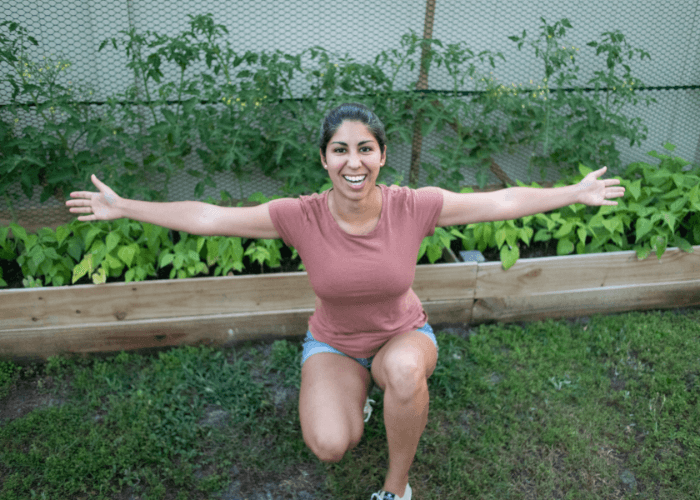
Disclosure: This post may contain affiliate links. If you purchase a product through one of our affiliate links we make a small commission from the sale at no extra cost to our readers.
How to MAX OUT Your Small Garden
Today I’m going to walk you through all of the techniques that I’m using in my garden to maximize gardening space.
Now, just for some context. I have a garden that is less than 100 square feet of space. And most of that is one long raised bed pushed up against the fence.
Sometimes I think it’s a lot more, but nope, it is 30 linear feet from one end all the way to the other, and 2 feet across, plus 2 more raised beds, one on either side, for a U shaped garden.
Use these small space gardening techniques to max out your small garden from now on!
1. Plant Companion Crops
If you’re not familiar with companion planting, basically it means to plant things together that benefit each other. Instead of vegetables that don’t like each other (yes, that is a thing.)
Now, this will take some research, but it’s not as complicated as it might sound.
One of the things I’ve just noticed is that some of my tomato leaves are getting a lot of pests.
And this specific damage is cutworm damage. Basically, these are some icky little worms that crawl all over your plants and cut the stems of the plants – especially seedlings.
So, of course, I can go about my normal pest control methods to get rid of (and hopefully prevent) cutworms.
Or I can work smarter, not harder and plant some sage near my tomatoes.
You see, sage naturally repels cutworms – which is perfect for keeping my plants cutworm free.
And at the same time, sage requires dry conditions – which works well since tomatoes benefit from being deep watered and going dry in between!
A good place to plant companion plants is actually underneath other things that grow vertically – like indeterminant tomatoes.
So, use that space to plant out companion plants and you will get twice the harvest and twice the benefits!
2. Grow Vertically
This is one technique I can’t recommend enough to max out a small garden space! I plant several vegetables vertically every planting season and have not regretted it once.
You see, plants that have a vining habit will grow just fine along the floor of the garden – and often times they will even root themselves into the soil along the vine.
But by putting in my little trellis along one side of my raised beds, it allows my vining vegetables to grow upwards instead of sprawling along the floor.
This saves so much space where you can then plant tons more vegetables. But it has several other benefits too!
By lifting up the leaves of the plants you can prevent disease spores and pests from finding your crops – both of which live on the soil.
Plus, it allows you to grow more things at the base of a plant – like more herbs or bush beans!
This is what I’ve done with my indeterminate tomatoes. I’ve planted them vertically in a way that is helping them grow along the back side of the fence. And then my bush beans grow right under them!
Here are some plants that can grow vertically:
- Indeterminate tomatoes
- Vining cucumber
- Squash (both winter and summer)
- Pole beans
Ideally, a plant such as a tomato plant needs one square foot but you stretch you small gardening space by planting companion plants right up underneath your tomatoes. This not only maximizes your space but helps the plants grow better also!
And for more plants to grow vertically, check out 10 Vegetable Plants That Can Be Trellised!
3. Practice Square Foot Gardening
Speaking of square feet, I absolutely love square foot gardening because I love being able to calculate exactly how many bean plants I can fit into one square foot!
Square foot gardening is a technique that allows you to plant multiple varieties of crops in a small space while giving them enough room to thrive.
And of course the nerdy part of my gets excited when I can actually calculate how much food I can grow in a space!
For example, in my 2×8 raised bed I have 16 total square feet.
So if I wanted I could plant out 16 tomato plants. Or 8 tomato plants and 48 bush bean plants. Or 6 tomato plants, 4 okra plants, and 2-3 zucchini plants.
The options are endless!
And from there it’s super easy to calculate how much food you’ll actually be able to harvest from that space.
Plus, square foot gardening has so many benefits which include:
- Built in companion planting
- Less weeding
- Easier crop rotation
- Ability to utilize a small space to it’s maximum capacity
Square foot gardening is something I talk about so much on this blog and over on my YouTube channel – and for good reason!
If you grow in a small space, square foot gardening is by far one of the best ways to max out your garden.
Psst…want to fast track your garden? Get access to my FREE gardening resource library and start maximizing your garden today!
4. Plant Out Densely
Despite the fact that I absolutely love square foot gardening, sometimes it’s okay to bend the rules a tad bit and plant things out more densely.
Now, there are certain crops you can get away with this on, and others that I definitely wouldn’t recommend it for.
With salad greens and things like herbs and other smaller seeded plants, I don’t really follow square foot gardening because they just don’t require that level of care.
I basically just take the entire packet and I just sprinkle it on top of the soil and what it grows is a sea of densely planted salad greens – and they’re perfectly happy that way!
You can do that with half the packet, a quarter of the packet, or whatever you want.
I probably sprinkled about half a packet for my mustard, kale, and arugula, and it is growing in really fast and it looks absolutely beautiful!
On the other hand however, you cannot do this with larger crops like tomatoes or brussel sprouts.
If you do, none of the plants are likely to grow.
However, if you’re growing indeterminate tomatoes up on a trellis, I have gotten away with planting them only 8-10 inches apart, instead of the recommended 12 inches.
Of course, you’ll have to use some common sense and go by your own experience. But overall with salad greens, herbs, and smaller plants planting densely will help you make the most of your garden!
5. Plant In Containers
Now, I do plant some of my crops, especially herbs, in pots. This saves tons of space for more plants in my actual raised beds.
For example, I have planted my spearmint in a pot because anything in the mint family tends to grow wild if you give it the space.
If I leave mine to grow on the ground, its runner vines will do just that— run. But in a pot, I’m able to control it and save the raised beds space for other more “calorie” dense crops that maybe won’t do well in a container.
In addition to my smaller pots of herbs, I also have 2 large rosemary plants in half wine barrels in front of the house. And because it grows nice, big, and bushy, the neightbors have no idea that it’s actually a culinary herb instead of just landscaping!
And you can absolutely plant potatoes, eggplant, lettuce, and many more plants in containers as “landscaping” and they will do just fine.
Plus, you’ll be able to put them in places that you normally wouldn’t think to grow crops – like in your front yard!
And you can even companion plant in containers.
For example, if you plant your lettuce in a container and there is still room, you can plant onions as a companion plant.
Not only do onions keep pests away, but they will also grow healthy and nice because lettuce has shallow roots, which gives the onions enough space to bulb up.
By combining several of these small space gardening techniques, you’ll be able to grow more food and get a bigger harvest!
Tips For Maxing Out Your Small Garden
These are some of my best tips for growing food in a small space. Follow them and your garden will be thriving in no time!
- Prioritize- plant crops that you need the most and those that you buy more from the grocery store
- Pick plants that are high-yielding. This will give you more food for your investment.
- Use containers to extend your space.
- Grow plants that use less ground space such vining cucumbers, indeterminant tomatoes, and winter squash.
- Give plants enough space- as much as you want to plant in every single space in your garden, squeezing in your plants leaves them no breathing space, which can have adverse effects on them.
- Don’t waste the shady part of your garden- some plants do well in shade. Find out which ones and plant them there.
How much food can a small garden produce?
The number I like to go by for determining how much food I can grow is 2-3 pounds per square foot. So if I’m working with 100 square feet of garden space I can grow, on average, between 200-300 pounds of food.
Now this will definitely depend on what crops you’re growing. But even with a good mix of vegetables you should be able to grow quite a lot in a small space by using a combination of square foot gardening, vertical gardening, and companion planting.
Plus, you can grow even more food by succession planting fast growing crops in the same space!
Keep in mind that the types of vegetables you plant will ultimately determine how many pounds of food you grow. For example, one herb plant might not produce a lot of weight in herbs, but one tomato plant can produce 10+ pounds of tomatoes!
And for more gardening resources, get access to our free gardening resource library! It will help you fast track your garden and it only takes 5 seconds!
PIN how to max out a small garden
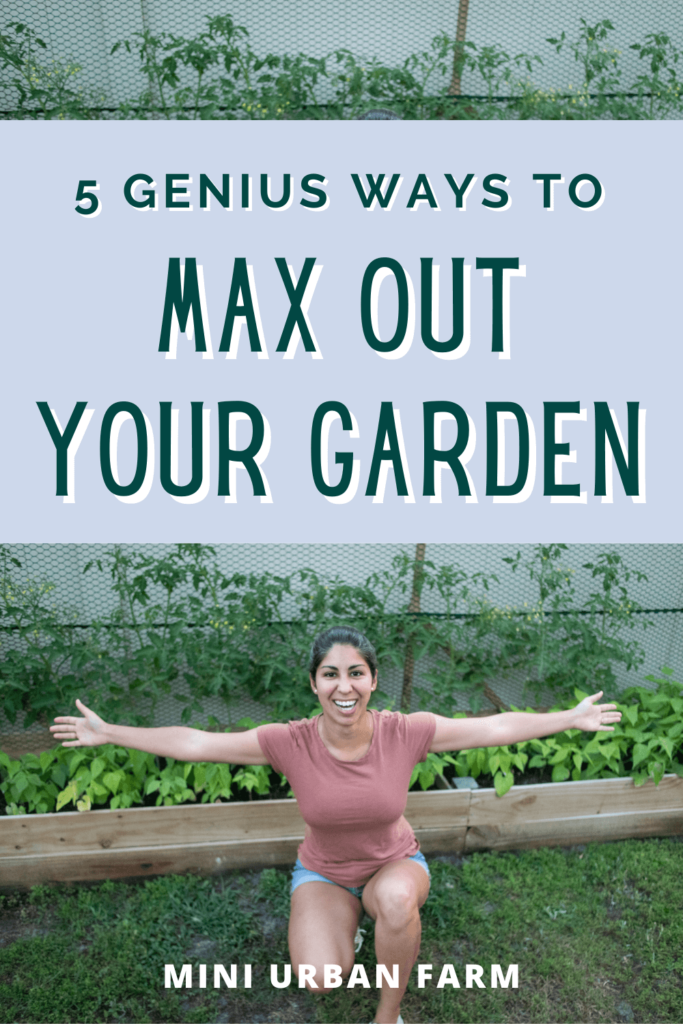
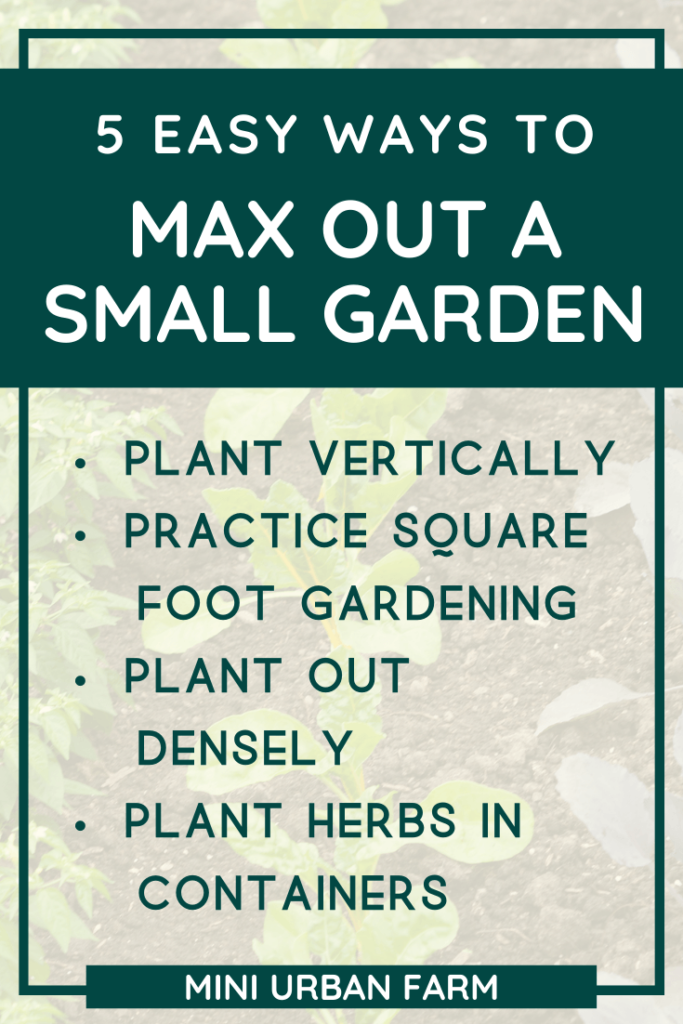
(add in the related posts for this category)

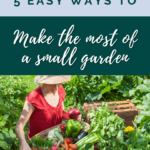
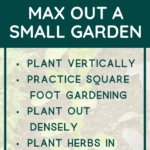
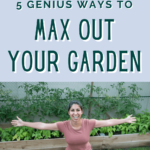
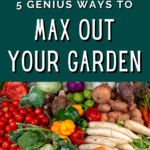
Pingback: How to Design an Urban Vegetable Garden in 5 Steps - Mini Urban Farm